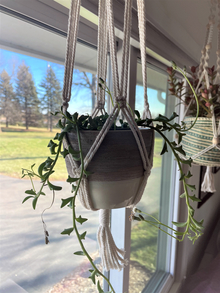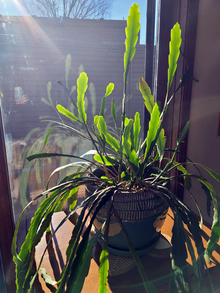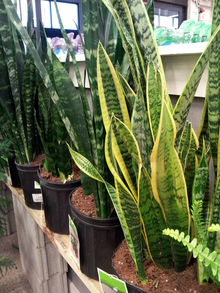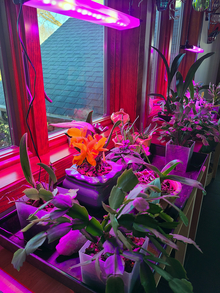Quick facts
- Sufficient light is important to growing healthy plants.
- Select a plant with requirements that match the light environment in your home or office.
- Supplemental lighting can make up for a lack of natural sunlight.
- There are many types of artificial lights in different styles and sizes to fit your needs and budget.
All plants require light for photosynthesis, the process by which a plant uses light to convert carbon dioxide and water into carbohydrates (energy). Oxygen is released as a byproduct of photosynthesis.
Plants require this energy to grow, bloom and produce seed. Without adequate light, carbohydrates cannot be manufactured, the energy reserves are depleted and plants die.
How plants are affected by too little or too much light
- When plants lack light, they don't produce chlorophyll (the green pigment in plants), and plants can turn pale green to yellow to white.
- Plant stems become “leggy,” meaning stems become long and thin and appear to be reaching toward the source of light.
- A lack of sufficient light causes the plant to grow long spaces on stems between the leaf nodes (the point where a leaf grows out from the stem).
- Plants without sufficient light may also drop their leaves, especially older leaves.
- You may find that a variegated plant (leaves that are white and green) may revert to being solid green.
- Flowering plants may fail to produce flower buds.
- Plants exposed to too much light may result in scorched and bleached leaves.
Choosing the right plant for your available light
Before getting a plant or starting seeds, determine the quality and hours of natural light in your space. Then choose plants with light requirements that match your indoor environment.
While a plant may tolerate lower light growing conditions, more light may be required to promote dense foliage and flowering.
Low light
(PPF: 50-150 umol m-2s-1 / 50-250 foot-candles / 10-15 watts)
- A low-light plant would be suitable for a north window or a fairly dark corner.
- Low-light plants require little to no direct light. In their native growing environments, these plants are “understory plants” meaning they grow underneath the branches of larger plants.
- Low lighting is not sufficient for starting seeds indoors.
- In environments with less light, plants grow more slowly and use less water. Avoid overwatering by feeling the soil.
Medium light
(PPF: 150-250 umol m-2s-1 / 250-1,000 foot-candles / 15-20 watts)
- A medium-light plant would be suitable for east-facing windows or located near a west-facing window, but out of direct light.
- You would need artificial lighting for starting seeds in medium light.
- Like the low light plants, these plants will not dry out as quickly. Avoid overwatering by feeling the soil.
High light
(PPF: 250-450 umol m-2s-1 / more than 1,000 foot-candles, more than 20 watts)
- A high-light plant would be suitable for brightly lit locations such as south- or southwest-facing windows.
- You may be able to start seeds without artificial lighting, but seeds that need more time indoors, such as tomatoes and peppers, may become leggy without extra light.
- High-light areas can be warm, making plants dry out faster. Check these plants more frequently and water when soil is dry.
Houseplants for different indoor light conditions
Just like choosing plants for sunny or shady areas of your outdoor garden, it’s important to choose plants that will grow in the existing light conditions indoors. And you may decide to add artificial grow lights to increase light energy to your plants.
The following houseplants are listed under the light conditions that provide the best indoor growing environment.
Low light is often loosely described as a light level "bright enough to read a newspaper." Most low-light plants are grown for their foliage, not flowers.
A low-light plant would be suitable for a north window or a fairly dark corner. In their native growing environments, these plants are "understory plants" meaning they grow underneath the branches of larger plants.
- Chinese evergreen (Aglaonema)
- Cast iron plant (Aspidistra)
- Ponytail palm (Beaucarnea recurvata)
- Parlor palm (Chamaedorea)
- Dumb cane (Dieffenbachia)
- Dracaena
- English ivy (Hedera helix)
- Sentry or kentia palm (Howeia)
- Homalomena
- Pothos (Epipremnum)
- Philodendron
- Lady palm (Rhapis excelsa)
- Snake plant (Dracaena trifasciata; formerly Sansevieria trifasciata)
- Peace lily (Spathiphyllum)
- Arrowhead plant (Syngonium)
- Zee zee plant (Zamioculcas)
These plants grow well indoors in areas that are well-lit such as in east-facing windows or near a west-facing window, but out of direct sunlight. You’ll often find medium-light plants in spaces where fluorescent lights are on all day such as an office building.
- Amaryllis (Hippeastrum)
- Elephant ear (Alocasia)
- Norfolk Island pine (Araucaria)
- Asparagus fern (Asparagus)
- Ferns
- Rubber plant (Ficus elastica)
- Fiddleleaf fig and weeping fig (Ficus)
- Begonias (Begonia)
- Spider plant (Chlorophytum)
- Grape ivy (Cissus)
- Aucuba leaf (Aucuba Japonica)
- Croton (Codiaeum)
- Jade plant (Crassula)
- Flame violet (Episcia)
- Schefflera (Schefflera)
- Wax plant, Hindu rope plant (Hoya)
- Peperomia (Peperomia)
- Monstera (Monstera deliciosa)
High light areas are brightly lit locations such as south- or southwest-facing windows. As a rule of thumb, most plants grown for their flowers require high-light growing conditions.
- Cacti and succulents
- Citrus such as calamondin orange, kumquat, Meyer lemon
- Hibiscus
- Culinary herbs such as basil (Ocimum), thyme (Thymus), lavender (Lavandula)
- Ti plant (Cordyline)
- Orchid cactus (Epiphyllum),
- Gardenia (Gardenia)
- Jasmine (Jasminum)
- Kalanchoe (Kalanchoe)
- Geraniums (Pelargonium)
- Poinsettia (Poinsettia)
- Non-hardy azalea (Rhododendron)
- Orchids
- Caladium
Adding artificial lighting
Artificial lighting can be added to make up for the lack of natural sunlight. Once you have an idea of the available light in your space and the plants you’d like to grow, you may decide to add supplemental lighting.
The most common types of lighting include LED and fluorescent bulbs, but you may see incandescent and high-pressure sodium bulbs when shopping around. There are pros and cons to using each type, and all can be found at local hardware stores or online.
LED (light emitting diode)
Pros
- Very energy efficient
- Long-lasting
- Wide spectrum of light
- Do not produce too much heat
- Wide variety of styles and sizes
Cons
- Higher up-front cost than other bulbs
- Bright lights can be distracting
Fluorescent
Pros
- Moderately energy efficient
- Cheaper up-front cost
- Some only produce light in the blue-green spectrum, but others have a wider spectrum that includes red light; check the label
Cons
- Do not last as long as LEDs
- Use more energy than LEDs
Incandescent
Pros
- Cheapest up-front cost
Cons
- Energy inefficient
- Create heat
- Do not last as long (in some cases)
- High far red light causes plants to stretch
High-pressure sodium and metal halide
Pros
- Emit substantial light over a wide surface area
- Most commonly used commercial light source
Cons
- Better for large-scale systems due to large size; need to be hung at tall heights
- Older technology
- Release a lot of heat
- Not all of the light is usable to plants
Light intensity
Light intensity is the brightness of light. The amount of light produced by a bulb is measured in a variety of ways and, unfortunately, two different bulbs may report their light output using different measurements, making it hard to compare. The distance between a light source and a plant impacts the light intensity.
While there are many ways to measure light, a few common measurements you are likely to see include:
- PPF (photosynthetic photon flux) is a measure of how much plant-usable light is released by a bulb per second and is measured in micromoles of light per meter per second (umol m-2s-1). You may also see PPFD (photosynthetic photon flux density), which is a measure of PPF as it reaches a surface like a plant leaf. PPFD goes down as your plants get further away from the light source.
- Foot-candle is the amount of light received by a 1-square-foot surface located one foot away from a light source equal to one candle. It’s not used as frequently though you may find this measure in older reference books.
- Lumens are less relevant when considering lighting for plants. Lumens measure how bright the light is to the human eye, and do not measure some of the important wavelengths that plants need to grow.
- Watts are a measure of the amount of energy needed to produce light, rather than a measure of the actual intensity of the light. Light bulbs should report both watts and another measure of light intensity such as PPF, lumens or foot candles. A more efficient lightbulb will produce more light with fewer watts of energy.
Distance from light source
Keeping sufficient distance between plants and a light source is especially important when using bulbs that produce a lot of heat, like incandescent and high-pressure sodium. But even with LED and fluorescent lights, maintaining a proper distance helps to ensure healthy plant growth.
- Seedlings: 4-6 inches (move your light up regularly as they grow)
- Hydroponic lettuce and herbs: 6-12 inches
- Foliage houseplants: 12-24 inches
- Flowering houseplants: 6-12 inches
Light quality
Light quality refers to the wavelength or color of light. The light spectrum is composed of red, orange, yellow, green, blue, indigo and violet light. Sunlight provides all colors of light.
The part of the light spectrum that plants use is called Photosynthetically Active Radiation, which is composed of primarily red and blue light.
As lighting technologies have become more efficient, grow lights that only emit light from the red and blue wavelengths of the light spectrum have become more common.
Check the packaging to see what type of light is emitted by a grow light before buying it; grow lights tend to be labeled as blue, red, or white/balanced light.
- Blue light or mixed light bulbs are suitable for starting seeds and leafy greens, as well as non-flowering house plants.
- Red light or mixed light bulbs are suitable for promoting bud formation in flowering plants as well as keeping the plants shorter.
- White lights or mixed/balanced light bulbs are suitable for most plants at any stage of growth.
Light duration
Light duration (photoperiod) is the number of hours of light a plant needs per 24-hour period. Plants are classified by photoperiod into three categories for flowering response: short day, long day, or day-neutral.
- Short day indoor plants, such as chrysanthemum, Thanksgiving and Christmas cacti and poinsettia, require short days to flower. You cannot reflower them indoors unless they are grown in short days.
- Long day plants, such as African violets, gloxinia and tuberous begonias, flower when the daylight exceeds the hours of the night period.
- Day-neutral plants are insensitive to day length differences for flowering and include indoor plants such as flowering maple (Abutilon), Crossandra, and gerbera daisies.
Use a timer to provide supplemental light if growing in a location with less natural light. Set your timer so that plants receive the following total light hours.
- Seedlings: 16-18 hours per day
- Hydroponic lettuce and herbs: 12-14 hours per day
- Foliage houseplants: 12-14 hours
- Flowering houseplants: 14-16 hours
Reviewed in 2024







